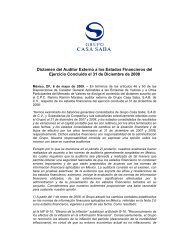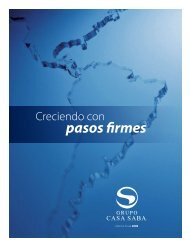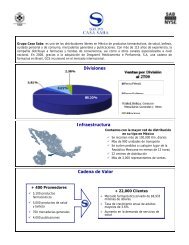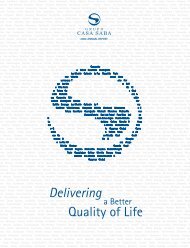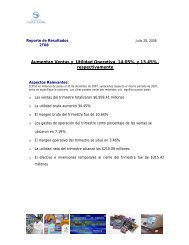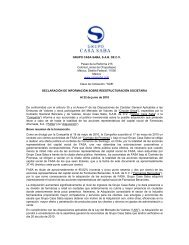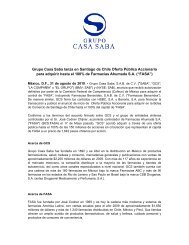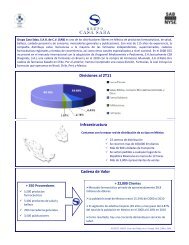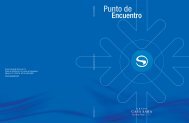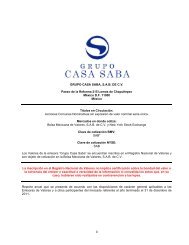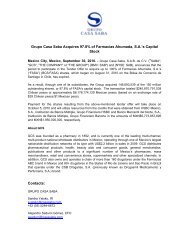FORM 20-F Grupo Casa Saba, S.A.B. de C.V.
FORM 20-F Grupo Casa Saba, S.A.B. de C.V.
FORM 20-F Grupo Casa Saba, S.A.B. de C.V.
You also want an ePaper? Increase the reach of your titles
YUMPU automatically turns print PDFs into web optimized ePapers that Google loves.
Table of Contents<br />
The Company recognizes the excess fair value of net assets acquired over the consi<strong>de</strong>ration paid as a bargain that is recognized by the acquiring entity by consi<strong>de</strong>ring: (i) reduces the<br />
value of the assets of the business acquired until they are exhausted, and (ii) the remaining balance is recognized as a nonordinary gain at the acquisition date.<br />
ii)<br />
Intangible assets<br />
Intangible assets are i<strong>de</strong>ntifiable nonmonetary assets, with no physical substance that represent costs incurred or rights acquired, which will generate future economic benefits<br />
controlled by the Group. Intangible assets are initially recor<strong>de</strong>d at acquisition cost represented by cash or cash equivalents paid at their estimated fair value at acquisition date if they<br />
are from a business acquisition. They are classified as <strong>de</strong>finite lived or in<strong>de</strong>finite lived intangible assets, in accordance with the period in which benefits are expected to be<br />
received. During high inflationary periods, those assets are restated by using NCPI factors applicable to the country where those assets are established. Through December 31, <strong>20</strong>07,<br />
the last date on which the Group operated in an inflationary economic environment, the value of those assets was restated by using the applicable NCPI factors.<br />
Intangible assets with <strong>de</strong>finite useful life<br />
These assets are amortized on their restated value when the economic environment is inflationary, as well as on the acquisition cost when the economic environment is not inflationary,<br />
in accordance with Mexican FRS B-10. Toward that end, the straight-line method is applied based on its remaining economic useful life. These assets are represented mainly by<br />
licenses related to the technological platform with which the Group operates. Development expenses are recor<strong>de</strong>d as intangible assets, provi<strong>de</strong>d that their technical viability and<br />
economic profitability are reasonably assured.<br />
Intangible assets with an in<strong>de</strong>finite useful life<br />
These intangible assets, including goodwill, are subject to periodic impairment tests, in the event of impairment indicators or at least once a year, by applying the “value in use” method<br />
of the cash generating units and taking into account a horizon whose projections do not establish growth rates beyond five years, unless a greater period is justified in accordance with<br />
Mexican Bulletin C-15 referred to above. Toward that end, “perpetuity value” is applied which consi<strong>de</strong>rs two stages: (i) the generation of excess of value in use of assets other than<br />
intangible assets with in<strong>de</strong>finite useful life and goodwill (“excess value in use”); and (ii) the recovery of carrying value of intangible assets and goodwill referred through<br />
perpetuity. Perpetuity value results from “excess value in use” between projected periods, discounted at an appropriate discount rate. Therefore, the impairment loss is generated by<br />
the excess of carrying value over perpetuity value referred to above. If goodwill and another intangible asset with in<strong>de</strong>finite useful life are subject to impairment at the same time, the<br />
resulting loss is applied to goodwill first.<br />
The Group consi<strong>de</strong>rs that the value in use through its cash flow projections is the best estimate of future cash flows from continued use of the cash generating unit. Therefore, the cash<br />
flow projection mo<strong>de</strong>ls recognize medium and long-term economic variables fairly at the time of the calculation, which are related to the future estimated price of products, changes in<br />
operating expenses, industry economic trend, and discount and growth rates applied in perpetuity.<br />
o) Lease<br />
Operating lease<br />
This transaction is classified as an operating lease when the risks and benefits inherent to the ownership of the leased asset remain substantially with the lessor. Total payments are<br />
charged to operating income for the period.<br />
F-25



